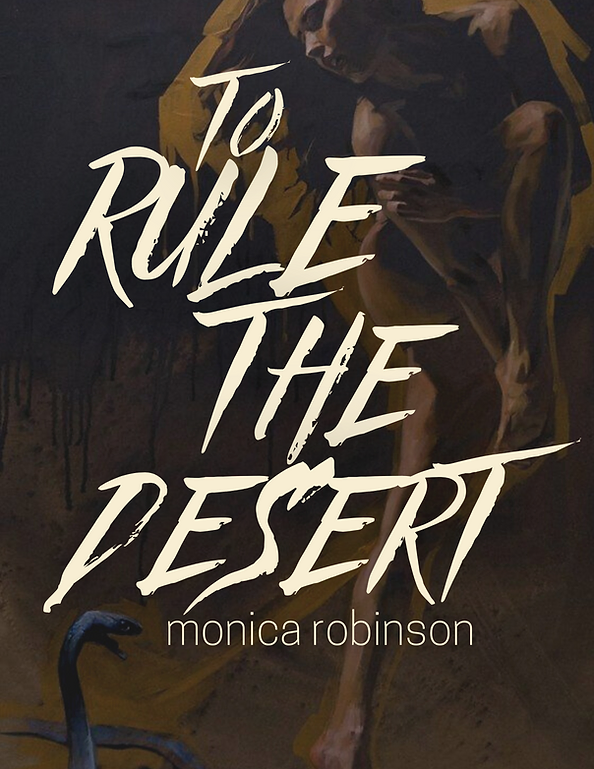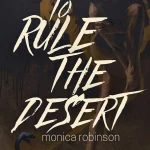
From poet, editor, and artist Monica Robinson comes to rule the desert, a sun-baked desert gothic, releasing on MAY 18TH in print and digital editions.
 From the original juggernaut, Madeline Miller’s Song of Achilles, to Wrath Goddess Sing by Maya Deane, The Silence of the Girls by Pat Barker, Natalie Haynes‘ entire body of work, and many more–books inspired by Greek mythology are having a cultural moment. Classical structure, truisms, and riffing abound in modern Western horror, including last year’s A Wounded Fawn, The Killing of a Sacred Deer, Spring, and Oldboy. The queerness of many literary adaptations meets the bloody, wild tropes of mythic horror films in to rule the desert, which follows lovers Ava and Quinn across a contemporary River Styx and beyond. A slim but powerful book, to rule the desert also dovetails with the rising popularity of sunlit horror (think Midsommar, The Noonday Witch, The Reflecting Skin, or even Picnic at Hanging Rock). Author Monica Robinson divulges her relationship to myth and landscape in a chat with DIS/MEMBER.
From the original juggernaut, Madeline Miller’s Song of Achilles, to Wrath Goddess Sing by Maya Deane, The Silence of the Girls by Pat Barker, Natalie Haynes‘ entire body of work, and many more–books inspired by Greek mythology are having a cultural moment. Classical structure, truisms, and riffing abound in modern Western horror, including last year’s A Wounded Fawn, The Killing of a Sacred Deer, Spring, and Oldboy. The queerness of many literary adaptations meets the bloody, wild tropes of mythic horror films in to rule the desert, which follows lovers Ava and Quinn across a contemporary River Styx and beyond. A slim but powerful book, to rule the desert also dovetails with the rising popularity of sunlit horror (think Midsommar, The Noonday Witch, The Reflecting Skin, or even Picnic at Hanging Rock). Author Monica Robinson divulges her relationship to myth and landscape in a chat with DIS/MEMBER.
Dee Holloway: to rule the desert is a loose re-envisioning of the myth of Orpheus and Eurydice. What part of this myth did you find most eternal, or simplest to transplant into a contemporary American setting?
Monica Robinson: Honestly, the piece that came first in all of this, the one that really made it clear that I was writing at least a very vague re-imagining and not simply an independent story, was the idea of the modern River Styx ferryman reconstructed as a truck-driving highwaywoman on the eternal open road. We already have a lot of modern American myth that has its early ties to these Greek and Latin influences, and it wasn’t hard to picture this particular piece of the story, especially as I am someone already enamored with the unique strangeness and infinite nature of road trips. America as a country is so vast, with so many small unexplored secrets, hidden back roads, etc, and growing up in one of these pockets gave me a basis for dreaming up what might be hiding in those that I haven’t yet explored.
DH: What does “desert gothic” mean to you, within the broader context of gothic literature and media? What makes a book a desert gothic versus a Western?
MR: When I first started doing genre research to figure out exactly where I should place this when marketing it, I ran into a lot of writing about “Western gothics”, and while my work is at least adjacent to this genre, there tends to be a lot more action in a true Western gothic, where to rule the desert tended a lot more towards a combination of literary and speculative fiction. I’m already a huge fan of regional gothics, especially my familiar Midwestern gothic haunts, and so it only felt right to make this a regional gothic as well, albeit set in what was a new locale for me. I think the most important thing with a regional gothic is remembering to acknowledge where the folklore in the area truly stems from and paying appropriate homage to that history, and so it felt right to distinguish this as a “desert gothic” instead of a “Western gothic”, because the folklore here stretches further than just what we consider “Western culture,” living in the very desert itself.
DH: What prompted you to make certain stylistic choices for the book, such as present tense and the italicized codas beginning or ending chapters?
MR: I really wanted this to bridge some of the gap between my short-form work, creative prose and poetry in particular, and I felt that experimenting with the bounds of what traditional speculative fiction (what an oxymoron!) allows us to do. My intention was always for Quinn to be the one telling the story, whether that’s through the first-person narrator, or in the subtle implication that she’s the one writing the story down after the fact, which is where the italics come in. There’s almost a frame narration given by Quinn that contextualizes the story to some degree and in turn acts as Quinn creating her own myth within the context of the story, so that the myth itself is given a circular existence that really speaks to me as both a poet and a fiction writer, one obsessed with chronicling my existence through writing.
DH: What other media influenced the aesthetic, atmosphere, setting, and/or other elements of To Rule the Desert? Do you have a favorite desert story or song?
MR: I’m incredibly ashamed to admit that a big chunk of it was inspired by Fallout: New Vegas. Not aesthetic at all, I know. But I did a lot of urbexing as a teenager, and I love exploring abandoned buildings, especially exploring what’s been left behind in them. It’s both incredible story fuel, and simultaneously fascinating and haunting, and a lot of what you do in New Vegas outside of the main plot is explore abandoned buildings and pick out stories from what’s been left behind. I moved apartments in January of 2022 during a huge ice storm, and there were a lot of vaguely traumatic things happening in my personal life at that point, so after we moved, I was too sore to do anything else and too exhausted to really deal with anything emotionally, and I would just veg out and play Fallout for hours at a time. And in a way, that depression, or at least how I coped with it, eventually turned into a full work, so I’m at least very proud of that for myself.
I also ended up reading Desert Creatures by Kay Chronister while doing edits, which really helped seal some of the ambiance for me. Station Eleven by Emily St. John Mandel gave me a touch of the roving, liminal nature of places left behind, and I also spent a lot of time writing to Ethel Cain‘s Preacher’s Daughter album. “Demolition Lovers” by My Chemical Romance was another song that made the early writing playlist, because the story it tells is really adjacent to some of the themes in to rule the desert as well. I listen to a lot of music while writing, a lot that fell into the dark country/southern gothic/western rock genres for this particular work, but I also have an Ava and Quinn playlist that was frequently on repeat. I also wrote a short story quite a few years ago about a liminal desert landscape, and though the story itself needed some work and never made it to publication, I did draw on those themes for this as well! I love recycling old work, because it feels like an Easter egg just for me.
DH: Do you have a favorite myth, from the Greek canon or another world culture?
MR: This might sound questionable, and has only a little to do with to rule the desert, but I always been enthralled by Clytemnestra’s story. I remember discussing it in one of the few college classes I actually finished, and the room was divided into those who thought she was a terrible, murderous figure, and those that felt she was entirely justified in her actions. I think some of the feminine revenge and rage that lingers throughout to rule the desert comes from my initial reaction to reading and discussing this myth in particular.
DH: What’s next for you in the publishing realm?
MR: This is such a loaded question, only because I don’t have any less than three projects all going on at once! I’m currently laying the groundwork for a poetry and art chapbook that will act as a sister release to my previous chap, peeling the yellow wallpaper. The poetry is mostly finished, so I’m currently focusing on the paintings, and then I’ll start to digitally lay everything out with the black background and all of the fun graphic details. This one will be about the idea of the red string of fate, and has a heavy focus on liminal spaces, which made it a great place to jump to after writing and editing to rule the desert. I’m also currently editing a full-length poetry manuscript that I’d like to try to get published traditionally if possible, and I just started the very faint beginnings of my first full-length novel! Although I am sure that will be a few years in the making, which I’m trying to be okay with coming from a history of shorter projects and a deep love for feeling like I completed something.
Feeling the itch to hit the open road, whether it leads to a utopian west or the depths of the underworld? Grab to rule the desert from the author’s online store or through her magical workplace, Philly’s own The Spiral Bookcase! Thanks to Monica for these thoughts, and happy reading to all.

![[FANTASPOA FEST] ‘CEMETERY OF LOST SOULS’ IS A BLOODY, MYSTICAL HISTORY LESSON](https://www.dis-member.com/wp-content/uploads/2021/04/Cemetery-of-the-Lost-Souls-1-150x150.jpg)
![[REVIEW] BOSTON UNDERGROUND FILM FESTIVAL — SCI-FI SHORTS](https://www.dis-member.com/wp-content/uploads/2019/03/8c3ab398-150x150.jpg)
![[NIGHTSTREAM] ‘DETENTION’ DELVES INTO THE GHOSTS OF TAIWAN’S PAST](https://www.dis-member.com/wp-content/uploads/2020/10/DetentionPromo-150x150.jpg)


Average Rating